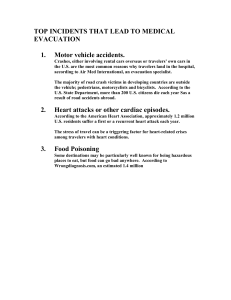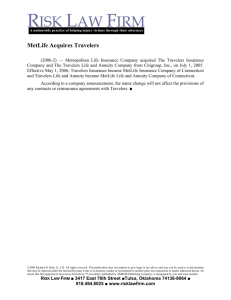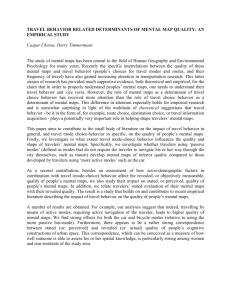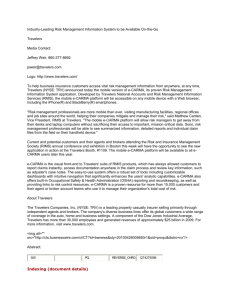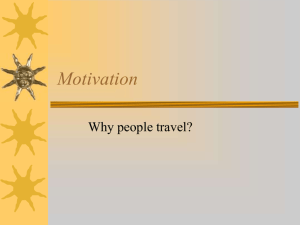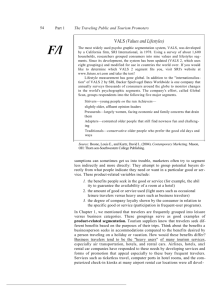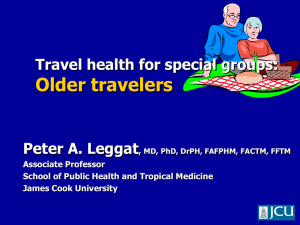PowerPoint Presentation - Center for Global Health
advertisement
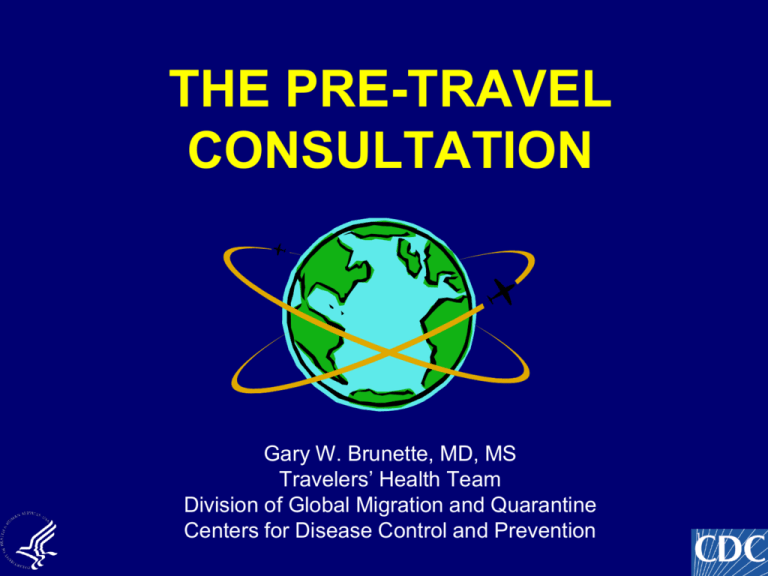
THE PRE-TRAVEL CONSULTATION Gary W. Brunette, MD, MS Travelers’ Health Team Division of Global Migration and Quarantine Centers for Disease Control and Prevention 1 Outline • • • • • • • • Travelers’ Health Epidemiology Traveler Assessment Itinerary Review Sources of Information Risks to the Traveler Travel Vaccines Travel Medications Counseling 2 65 60 55 50 20 05 20 04 20 03 20 02 20 01 20 00 19 99 19 98 19 97 19 96 45 19 95 Number of Travelers (millions) U.S. Residents Traveling Abroad* Year *ITA, includes travel to Canada and Mexico 3 80 900 70 800 700 60 600 50 500 40 400 30 300 20 200 10 Worldwide arrivals in millions US Resident travel in millions International Travel US nonresident Inbound (ITA) US Resident Air Outbound (ITA) All US Resident Outbound (ITA) Worldwide arrivals (WTO) 100 0 0 1996 1997 1998 1999 2000 2001 2002 2003 2004 2005 4 Where Do U.S. Residents Travel? Of the 17% who traveled outside the U.S. . . . 40 % 30 20 10 0 Ca da a n E pe o ur Au Z s /N ico ic a r x e m Me A S or C n ia PI a s / p a rA ni Ja e a h e Ot Oc t a n s c a i a r be Af eE b l i r dd i Ca M 5 Source: HealthStyles Survey 2005 VFRs: Visiting Friends and Relatives • Foreign-born increased 57% since 1990 from 19.8 million to 31.1 million1 • 20% of US population are first- or second-generation immigrants • VFRs comprised ~46% of US international air travelers in 20043 1US Census Bureau, Census 2000 Brief, The Foreign-Born Population: 2000, issued Dec 2003 (Previous: US Census Bureau, Profile of the Born Outside the United States Population 2000, issues Dec 2003??? 2 Angell & Cetron, 2005 32004 Profile of U. S. Resident Travelers Visiting Overseas Destinations Reported From: Survey of International Air Travelers, Office of travel and tourism Industries, 6 USDOC Travelers’ Health Risks Of 100,000 travelers to a developing country for 1 month: – 50,000 will develop some health problem – 8,000 will see a physician – 5,000 will be confined to bed – 1,100 will be incapacitated in their work – 300 will be admitted to hospital – 50 will be air evacuated – 1 will die Steffen R et al. J Infect Dis 1987; 156:84-91 7 The Patient: Medical Issues • Age-specific issues • Underlying illness, immunosuppression • Systems review • Medical history • Medication use • Vaccination history • Allergies • Contraindications to vaccines and medications 8 The Patient: Other Issues • Reproductive – Pregnant – Breastfeeding – Preconception • Risk-taking behaviors 9 Travel Itinerary • Full itinerary – Dates, duration, stopovers – Seasonal considerations • Styles of travel – Rural vs. urban – Budget vs. luxury • Accommodation – Hotel vs. camping • Activities – Business vs. tourism – Adventure, safari – Missionary/Humanitarian/NGO 10 Travel Health Resources • CDC Travelers’ Health Website – www.cdc.gov/travel • World Health Organization – www.who.int/int • State Department – travel.state.gov • International Society of Travel Medicine – www.istm.org • Health Information for International Travel – CDC “Yellow Book” • International Travel and Health – WHO “Green Book” 11 Travelers’ Health Website www.cdc.gov/travel 12 Regional Destinations • Region-specific pages • Goal to move to country-specific format 13 Travel Notices & Announcements 14 Deaths Related to International Travel Cardiovascular Medical Injury Homicide/Suicide Infectious Disease Other N = 2463 Hargarten S et al, Ann Emerg Med, 1991. 20:622-626 15 Infectious Disease Risks to the Traveler • • • • • • • • • • • • • Malaria Diarrhea Leishmaniasis Rabies Dengue Meningococcal Meningitis ETC. Schistosomiasis Tuberculosis Leptospirosis Polio Yellow Fever Measles JEV 16 Injury Deaths and International Travel Motor Vechicle Drowning Air Crash Homicide/Suicide Poisoning Other N = 601 Hargarten S et al, Ann Emerg Med, 1991. 20:622-626 17 Other Risks to the Traveler • • • • • • • • Accidental injury Environmental hazards Crime and assault Psychiatric problems Animal bites, stings and envenomations Dermatologic disorders Altitude ……. ETC. 18 Immunizations to Consider for Adult Travelers Routine Diphtheria* Tetanus* Pertussis* Measles + Mumps+ Rubella + Varicella Pneumococcus Influenza * Td or Tdap + MMR Travel related Hepatitis A Hepatitis B Typhoid Rabies Meningococcal disease Polio Japanese encephalitis Yellow Fever 19 Travel Medications: Prophylaxis & Self Treatment • Malaria – chloroquine, atovaquone/proguanil (Malarone), doxycycline, mefloquine (Lariam), primaquine • Diarrhea – quinolone, azithromycin • Altitude – acetazolamide • Motion sickness – scopolamine, dimenhydrinate (Dramamine) 20 Patient Counseling • Sufficient time for patient education • Tailored to suit traveler • Fitness for travel – Understanding impact on existing conditions – Advisability of destinations 21 Travel Preparation • Travel health insurance – Medical care – Hospitalization – Evacuation • Obtaining medical care abroad • Awareness of travel notices • Hand washing and hygiene 22 Environmental Precautions • • • • Air Travel Jet Lag Sun Protection Extreme Heat and Cold – dehydration, heat stroke – hypothermia, frostbite • Altitude • Water recreation – Drowning, boating & diving accidents – Risk of schistosomiasis or leptospirosis – Biological and chemical contamination 23 Food and Water Precautions • Bottled water • Selection of foods – well-cooked and hot • Avoidance of – salads, raw vegetables – unpasteurized dairy products – street vendors – ice 24 Vector Precautions • • • • • • • • • Covering exposed skin Insect repellent containing DEET 25 – 50% Treatment of outer clothing with permethrin Use of permethrin-impregnated bed net Use of insect screens over open windows Air conditioned rooms Use of aerosol insecticide indoors Use of pyrethroid coils outdoors 25 Inspection for ticks Bloodborne and STD Precautions • Prevalence of – – – – • • • • • • STDs Hepatitis B Hepatitis C HIV Unprotected sexual activity Commercial sex workers Tattooing and body piercing Auto accidents Blood products Dental and surgical procedures 26 Animal Precautions • Animal avoidance • Rabies – Specific animal threats – Medical evaluation of bites/scratches – Post exposure immunization and immunoglobulin • Envenomations – Snakes, scorpions, spiders – Maritime animals 27 Injury and Crime • Vehicles – Risk of road and pedestrian accidents – Night travel – Seat belts and car seats • Use of drugs and alcohol • Understanding local crime risks – Scam awareness – Situational awareness – Location avoidance 28 Travel Emergency Kit • Copy of medical records and extra pair of glasses • Prescription medications • Over-the counter medicines and supplies – Analgesics – Decongestant, cold medicine, cough suppressant – Antibiotic/antifungal/hydrocortisone creams – Pepto-Bismol tablets, antacid – Band-Aids, gauze bandages, tape, Ace wraps – Insect repellant, sunscreen, lip balm – Tweezers, scissors, thermometer 29 Post-Travel Care • Post-travel checkup – Long term travelers – Adventure travelers – Expatriates in developing world • Post-travel care – Fever, chills, sweats – Persistent diarrhea – Weight loss 30 Questions? 31 Other Resources 32 Journals • American Journal of Tropical Medicine and Hygiene • Bulletin of the World Health Organization • Emerging Infectious Diseases Journal • Eurosurveillance Weekly • Journal of Travel Medicine • Morbidity and Mortality Weekly Report • Tropical Medicine and International Health • Vaccine 33 Books • Textbook of Travel Medicine and Health, 2nd Ed. – DuPont, H.L. and Steffen R. (editors) • The Travel and Tropical Medicine Manual, 3rd Ed. – Jong, E.C., McMullen, R. • Travel Medicine – Keystone, J.S., Kozarsky, P.E., et al 34 Websites Eurosurveillance www.eurosurveillance.org Travax EnCompass www.travax.com GIDEON www.gideononline.com International SOS www.internationalsos.com Medical Advisory Service for Travelers Abroad (MASTA) http://www.masta.org/ Armed Forces Medical Intelligence Center www.afmic.detrick.army.mil/ Central Intelligence Agency www.cia.gov/cia/publications/factbook/ 35
